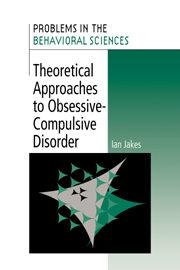Book contents
- Frontmatter
- Contents
- Dedication
- Synopsis of Theoretical approaches to obsessive-compulsive disorder
- Acknowledgments, and provenance of Theoretical approaches to obsessive-compulsive disorder
- 1 The natural history and definition of obsessive-compulsive disorder
- 2 Behavioural/learning accounts of OCD
- 3 Accounts of OCD based upon personality theories derived from the work of Pavlov
- 4 Janet on OCD
- 5 Psychodynamic approaches to OCD
- 6 Cognitive style/deficit approaches to OCD
- 7 Biological approaches to OCD
- 8 Concluding remarks
- References
- Author index
- Subject index
2 - Behavioural/learning accounts of OCD
Published online by Cambridge University Press: 07 May 2010
- Frontmatter
- Contents
- Dedication
- Synopsis of Theoretical approaches to obsessive-compulsive disorder
- Acknowledgments, and provenance of Theoretical approaches to obsessive-compulsive disorder
- 1 The natural history and definition of obsessive-compulsive disorder
- 2 Behavioural/learning accounts of OCD
- 3 Accounts of OCD based upon personality theories derived from the work of Pavlov
- 4 Janet on OCD
- 5 Psychodynamic approaches to OCD
- 6 Cognitive style/deficit approaches to OCD
- 7 Biological approaches to OCD
- 8 Concluding remarks
- References
- Author index
- Subject index
Summary
An outline of the model
The behavioural/learning account of OCD (e.g., Eysenck and Rachman, 1965) is based on Mowrer's (1939,1960) “two factor” theory of learning. This approach provides very similar accounts of both OCD and phobic states. The preoccupations of OCD patients are held by this approach to concern feared stimuli that have acquired anxiety-producing properties by a process of classical conditioning. The behavioural/learning account suggests that the compulsions provoked by these feared stimuli are escape or avoidance behaviour. According to this account, this behaviour reduces or prevents anxiety and is thus reinforced by a process of instrumental conditioning. De Silva (1988) suggests that “the model is essentially one of learned anxiety reduction”. In the case of OCD, as in the case of phobias, the avoidance behaviour may be passive (for example, not approaching objects thought to be contaminated) or active (for example, checking for contamination [Gray, 1982, p. 440]). An example of an OCD escape behaviour is cleaning to remove what is thought to be some contamination.
The model is not substantially altered by the recognition that it is not only anxiety but also other forms of mood disturbance, subsumed under the vaguer term “discomfort” (Rachman and Hodgson, 1980), that is reported by some OCD patients. The maintenance of compulsions is then attributed to learned discomfort reduction (de Silva, 1988).
Consistent with this account, Rachman and his co-workers (e.g., Hodgson and Rachman, 1972; Rachman, de Silva, and Roper, 1976; Rachman and Hodgson, 1980) have shown that compulsions are indeed often provoked by environmental cues, and that when OCD patients are exposed to these cues they experience an increase in anxiety or discomfort.
- Type
- Chapter
- Information
- Theoretical Approaches to Obsessive-Compulsive Disorder , pp. 28 - 45Publisher: Cambridge University PressPrint publication year: 1996



